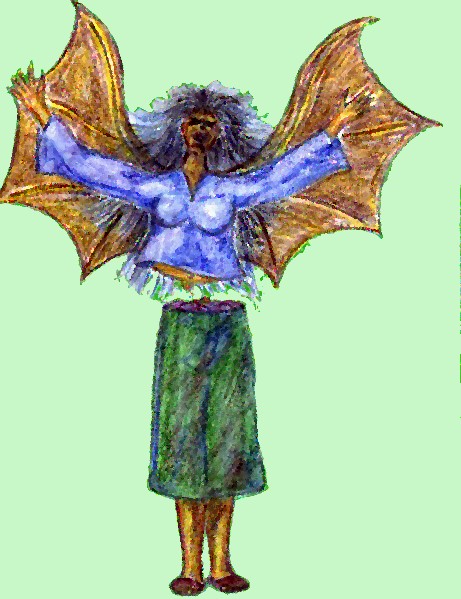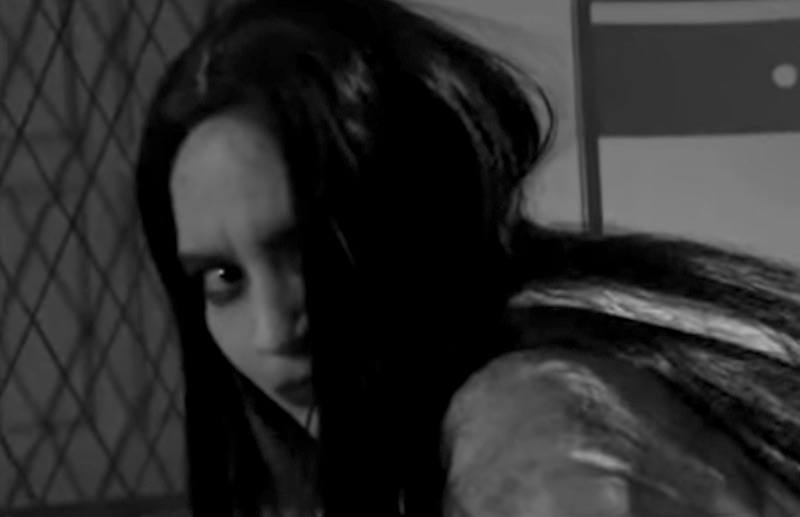From our common pastime exchanging spooky encounters while serving National Service to our bestselling True Singapore Ghost Stories series, Singaporeans really do enjoy reading and listening to spine-chilling tales.
Seeing as how y’all circulated posts about the (now debunked) Yishun child-stealer and enjoyed our explainer of urban legends involving malicious entities knocking on HDB doors, we thought you’d like to know more about an iconic figure in local ghost-lore: The Pontianak.
White-robed, long unkempt black hair, red eyes — all standard hallmarks of standard Asian female wraiths familiar to folks from Japan to Indonesia. In the Malaysian and Indonesian context though, pontianaks are spirits of women who died while pregnant, roaming the lands as violent spectres determined to suck blood and steal babies. Detection of their presence is usually by smell (frangipani, followed by corpse stench) and sound (soft baby cries when they’re close by, loud cries when they’re far away). Often, they seduce horny young men by looking like total sultry pale-skinned bombshells before transforming into hideous monstrosities once they’re within arm’s length.
Our fascination with the iconic ghost has permeated so deeply in society that one of our first local horror film series was a trilogy about the pontianak. Filmmaker B.N. Rao premiered his film Pontianak at Cathay cinema in Dhoby Ghaut in 1957, and it proved to be a hit among Indian and Chinese communities, despite being a Malay film. Under Cathay-Keris Productions, Rao followed up with two more sequels Dendam Pontianak (Revenge of the Pontianak) in 1957 and Sumpah Pontianak (Curse of the Pontianak) in 1958. Fun fact, Zubir Said — the creator of our national anthem — composed music for the films.

But we don’t have to go into detail about the pontianak — we’re pretty sure you’ve already had a fair share of eerie stories told by others (or you’ve survived an encounter with one). Pivoting to another perspective you’ve probably never thought of before, we approached LASALLE College of the Arts Senior Lecturer Adeline Kueh for a more academic interpretation of the pontianak folklore.
Why her? For one, she actually gave a lecture at The Substation back in September called Pontianak & Her Sisters — a look into the conceptual category of ghost stories focusing on the construct of the ‘pontianak’ and her ‘sisterly’ counterparts within the contexts of folklore, fiction and film. Tickets to her lecture ran out pretty fast to the dismay of many, but we managed to catch Kueh recently to find out what you missed in her fascinating academic investigation into arguably Singapore’s scariest ghost.
How would you define a pontianak?
The Pontianak is said to appear sometimes in the form of an owl, but its most common form is that of “a beautiful woman who lures men to their doom”.
According to Allen Jean:
A woman who had died during or after childbirth becomes a pontianak. She is cursed [by] being denied the promise of peace in the kingdom of God (Allah). She is considered unclean, impure as she cannot fulfill her duty as a mother. The curse of immortality descends on her of having to “live” by draining blood from human hosts and not being able to die with the accorded dignity of proper burial rites.
So, tell us more about your deep interest in the subject of pontianak.
I grew up like Toto in Cinema Paradiso — my grand uncle owned a cinema in a small town outside Kuching, Sarawak and all our primary school holidays were spent there. As such, I have always had this long love affair with cinema.
When I did my masters and my focus was on the filmic representations of women in ’50s and ’60s film in Malaya, I was intrigued by the dichotomy between the good and fallen women. So you have the martyr mother, the virtuous virgin, the good daughter, and on the other end side, the fallen ones — the harlot/seductress/prostitute, witch, and the pontianak. Nearing the end of it, I kept thinking to myself how the cliché could be so true — “good girls go to heaven, bad girls go everywhere!”
So I began looking at the conceptual category of ghost stories focusing on the construct of the ‘pontianak’ and her Southeast Asian counterparts.
Who exactly are pontianak‘s ‘sisters’ then?
There are varying manifestations of spirits within our culture. The most popular is the variation of the Pontianak, a “gendered monster”, to borrow Barbara Creed’s term.The pontianak is the epitome of evil in our local folklore. Plus, stories about her have passed the test of time. There are many versions of her in our neighbouring countries too — examples of ‘her sisters’ are the Thai Nang Nak; Kuntilanak in Indonesia; and the Aswang and Manananggal of the Phillipines.

The Manananggal. Photo: Wikimedia Commons
In your lecture, you brought up the connection between female ghosts and the concept of femininity…
Psychoanalytic concepts of projection and projective inversion can be applied to the study of folktales in the construct of Pontianak, and the other ‘fallen women’. According to Alan Dundes, projection “refers to the tendency to attribute to another person or to the environment what is actually within oneself… some internal impulse or feeling which is painful, unacceptable, or taboo.”
For example, in the many versions of the Pontianak story, the ‘woman’, more often than not, changes from one being seductive to suddenly monstrous. The sight (and sometimes scent) of a ‘beautiful’ woman gives way to the ‘evil within’. Perhaps serving as a warning, I would suggest that it is indicative of a certain tradition that dominates within Malayan folklore which constructs negative connotations around female sexuality. Women who overtly exudes their sexuality (read: power) cannot be considered ‘good’.
Furthermore, much of the meaning of folkloric fantasy is unconscious, particularly in a Freudian sense, that “[a]mong its functions, folklore provides a socially sanctioned outlet for the expression of what cannot be articulated in the more usual, direct way.” Folktales thus represent the site within which the anxieties of the Malayan culture can be vented. Within the narrative of the ghost story, the pontianak becomes the embodiment of female ‘difference’ and that which is despised or repressed within the culture.

That makes sense — what other socio-historial concerns are related to the pontianak?
Pontianak, like many monsters, exists more at the time of turmoil, or when negotiations about contradictions of socio-economic roles in society are being made at a daily level.
In popular culture, pleasure is constructed primarily through sexual difference. While there are stories which tell of women spotting the Pontianak, the target audience still is presumably male. At the very least, the female reader/viewer are masculinized in the sense that they are presented stories from a male point of view, carrying the age-old tradition of the worry-dispeller.
In these stories, there are elements of sexual attraction, expected gender roles, supporting the social structures of particular societies. Often times, like in films of particular societies (for instance, in Bollywood), the ideologies expounded within popular culture suggest a reaction to the various social movements or even social realities of contemporary women.
Sexual symbolism and innuendos also permeate the ghost stories, further exemplifying heterosexual relationships. The tension and impact of these stories are more ‘potent’ when it is between the female ghost and her often times chauvinistic, unsuspecting but virile (of course) male who presupposes a romantic liaison. Cultural stereotypes of femininity, often hinging on vanity are played out through the focus on the ‘beauty’ and ‘sensuality’ of the ghosts.

Damn, that’s heavy. On that note, why do you think the pontianak remains a very real fear among Singaporeans even today?
In terms of the relationship between folklore and social reality, ghost stories and folktales from SEA region draw their popularity from the reader’s (and viewer’s) familiarity with local folklore. Dundes argues that large portion of folklore is fantasy, collective or collectivized fantasy – in fact, “[f]olktales…, like all folklore, have passed the test of time, and are transmitted again and again. Unlike individual dreams, folktales must appeal to the psyches of many, many individuals if they are to survive.”
Within this genre of popular horror fiction, we could argue that the ways in which language (both in film and ghost stories) frames the situations are worth mentioning: presented from a Bourgeois/middle class point of view, the binarisms between good and evil, urban and provincial, religious and ‘ritualistic’ seem to be partial towards the point of view of the ruling majority.
These stories represent women (and sometimes other underclass) as a threat and the threat/s perceived within folklore may be traced to the influx of particular religions into our region. The result was a conflict between folklore or traditional beliefs, and religion. Folklore amongst the earlier indigenous Malay people involved animalistic or pagan beliefs and had closer matrilineal ties and traditions (such as the Minangkabaus and the Melanaus).
Like the Matianak myth, in all the examples, these traditions were gradually suppressed by the spread of Islam, Christianity and Buddhism and their respective (patriarchal) traditions in the examples I am referring to. According to Felicidad Lim, ghost stories are very much related to rituals of magic which should not be seen as having just projected onto films, but rather, magic exists alongside films in the popular imagination of the people.

You really know a lot about these things. But here’s the golden question — do you personally believe that pontianaks exist?
This is a question I get a lot — my answer is that it isn’t so much about whether they exist or not for me because I think of spirits and ghosts co-existing with us perhaps in ways we cannot explain scientifically as yet, but for me, the interest in this phenomenon stems from how I feel that these monsters reflect more about the culture and people that bore them.
Essential readings and films if one wants to be a pontianak expert as well?
There are too many books, too little time, literally. I’m including a list here but it may take up too much space. I am happy to provide more readings if anyone is interested.
- Cohen, J. “Monster Culture (Seven Theses)” in Monster Theory: Reading Culture, Cohen, J. (ed.), Minneapolis: University of Minneapolis Press, 1996.
- Haji Bujang, Rahmah. “Kisah Purba – Plot Moden/Ancient Tales – Modern Plots.” In Cintai Filem Malaysia/Love Malaysian Films. Ampang: Perbadanan Kemajuan Filem Nasional Malaysia, 1989.
- Kueh, Adeline. “The Filmic Representations of Malayan Women: An Analysis of Malayan Films from the 1950s & 1960s”, in Kunapipi: Journal of Post-colonial Writing, Vol. XXII No. 1, 2000.
- Lim, F. “The Politics of Horror: The Aswang in Film” in Asian Cinema, Fall 1997.
- Skeat, W. Malay Magic: An Introduction to the Folklore and Popular Religion of the Malay Peninsula. London: Macmillan and Co., 1900. Reprint. New York: Barnes and Noble, 1966.
- B.N. Rao’s Pontianak trilogy (1957-1958)
- Ramon Estella’s Anak Pontianak (1958)
- Sisworo Gautama Putra’s Sundel Bolong (1982)
- Peque Gallaga & Lore Reyes’ Shake, Rattle & Roll I-IV (1984-1992)
- Nonzee Nimibutr’s Nang Nak (1999)
- Shuhaimi Baba’s Pontianak Harum Sundal Malam (2004)




